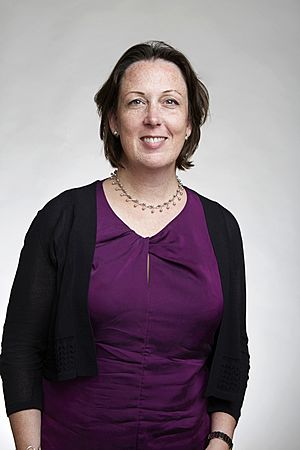Sheila Rowan (physicist) facts for kids
Quick facts for kids
Sheila Rowan
|
|
|---|---|

Sheila Rowan at the Royal Society admissions day in London, July 2018
|
|
| Born | 25 November 1969 Dumfries, Dumfriesshire, Scotland
|
| Alma mater | University of Glasgow (BSc, PhD) |
| Awards |
|
| Scientific career | |
| Institutions | University of Glasgow Stanford University |
| Thesis | Aspects of lasers for the illumination of interferometric gravitational wave detectors (1995) |
| Doctoral advisor | James Hough |
Sheila Rowan (born 25 November 1969) is a Scottish physicist and professor. She works at the University of Glasgow in Scotland. Since 2009, she has led the Institute for Gravitational Research there. Professor Rowan is famous for her important work in finding gravitational waves. These are ripples in space and time.
In 2016, she also worked part-time as the Chief Scientific Advisor for the Scottish Government. She is a member of several important groups, like the Royal Society of Edinburgh and the Royal Society. She has won many awards, including the Philip Leverhulme Prize and the Fred Hoyle Medal and Prize. She was also honored with the MBE in 2011 and the CBE in 2021.
Contents
Early Life and Education
Sheila Rowan was born on November 25, 1969, in Dumfries, Scotland. She went to Maxwelltown High School in Dumfries. After high school, she studied physics at the University of Glasgow.
She earned her first degree, a Bachelor of Science (BSc), in 1991. Then, she continued her studies and received her Doctor of Philosophy (PhD) degree in 1995. Her PhD research was all about gravitational waves. Her supervisor, James Hough, guided her work.
A Career in Physics
After finishing her PhD, Professor Rowan worked in two places. She split her time between the University of Glasgow and Stanford University in the United States. Since 2003, she has worked only at the University of Glasgow. In 2006, she became a Professor of Experimental Physics there.
Discovering Gravitational Waves
Professor Rowan's research has focused on making special materials for gravitational wave detectors. These detectors are very sensitive tools. She led a team that was part of a big international project called Laser Interferometer Gravitational-Wave Observatory (LIGO).
In September 2015, the LIGO team made a huge discovery. They detected gravitational waves for the very first time! This was a big moment in science. It proved a prediction made by Albert Einstein many years ago.
Role in Government and Institutes
In June 2016, Professor Rowan took on another important role. She became the chief scientific advisor to the Scottish Government part-time. This job involves giving scientific advice to the government. She held this position until June 2021.
After that, she became the President of the Institute of Physics. She started this role on October 1, 2021. This institute is a leading group for physics in the UK and Ireland.
Awards and Recognitions
Professor Rowan has received many awards for her amazing work.
- In 2005, she won the Philip Leverhulme Prize for Astronomy and Astrophysics.
- She became a Fellow of the Institute of Physics (FInstP) in 2006.
- In 2008, she was elected a Fellow of the Royal Society of Edinburgh (FRSE).
- She also became a Fellow of the American Physical Society in 2012.
- In 2016, she received the Fred Hoyle Medal and Prize from the Institute of Physics. This was for her important work on the technology used in gravitational wave observatories.
- Professor Rowan and her team shared the 2016 Special Breakthrough Prize in Fundamental Physics. This was for their part in detecting gravitational waves.
- Also in 2016, she was part of a team that won the President's Medal from the Royal Society of Edinburgh.
- In 2017, she won the Suffrage Science award.
- In 2018, she was elected a Fellow of the Royal Society (FRS).
- In 2019, she was chosen to be the president-elect of the Institute of Physics. She officially became President in October 2021.
- In 2020, she won the Sir Harold Hartley Medal. This award is for great contributions to measurement and control technology.
- For her services to science, she was made a Member of the Order of the British Empire (MBE) in 2011. She was then promoted to Commander of the Order of the British Empire (CBE) in 2021.
Patents
In 2010, Professor Rowan received a patent from the European Patent Office. This patent was for a new way to bond silicon carbide. This is a special material used in many technologies. Her method allows silicon carbide parts to be joined together or to other materials.

